Alderney Nature Diary
September 2001
The Weather
12th was 3rd warmest September day since 1955. (1961 27.2ºC, 1984 25.0º). Conversely, 4th was the 7th coldest September day since 1955.
In UK it was the wettest September for 15 years, but Alderney had barely half last year's rainfall, only 2/3rds the long term average and was in fact the 13th DRIEST September since 1955. Most of the rain fell on just 4 days, with 14 days receiving either none, or less than 0.1mm.
Average temperatures, barometric pressures, humidity, wind speeds and direction, were not much different from last year. Totals of rainfall and sunshine for the year to date, were about the long term average, but both were considerably lower than last year, with 127mm less rain and 152 hours less sunshine.
Figures for comparison with September last year and the 20 year average
| Year |
2001 |
1999 |
20-year average |
| |
|
|
1980-99 |
| Rain mm. |
45.7 |
92.9 |
61.0 |
| Sun hrs. |
181.3 |
194.9 |
169.7 |
| Max. temp recorded °C |
24.8 |
22.5 |
21.5 |
| Min. temp recorded |
8.8 |
12.5 |
10.1 |
| Mean day temp |
17.5 |
17.6 |
17.9 |
| Mean night temp |
15.9 |
16.2 |
13.7 |
| Total rainfall, year to date, mm. |
435.0 |
562.4 |
464.5 |
| Total sunshine, year to date, hrs. |
1552.1 |
1704.6 |
1556.1 |
The Diary
1st September. Lots of cudweeds and fleabanes now in flower. Common, Small, Jersey and Cape Cudweeds (Filago vulgaris, (photo on left) F. minima, (photo on right below) Gnaphthalium luteo-album, (photo on left below) & G. undulatum), Canadian and Guernsey Fleabane (Conyza canadensis, C. sumatrensis), (photos below) in bare s
 andy ground or between paving slabs, as at Platte Saline and some of them elsewhere. Jersey Cudweed is rare in Alderney and has only been noted in the Platte Saline area. In Alderney Common and Small Cudweeds are not common anywhere, but Cape Cudweed and Canadian Fleabane are frequent in these sort of habitats, whilst Guernsey Fleabane, not recorded in Alderney before has now become more common in Jersey than the Canadian plant. This month Margaret Long one of the two Jersey BSBI recorders found a number of plants of it on Platte Saline common, (as well as two in my
andy ground or between paving slabs, as at Platte Saline and some of them elsewhere. Jersey Cudweed is rare in Alderney and has only been noted in the Platte Saline area. In Alderney Common and Small Cudweeds are not common anywhere, but Cape Cudweed and Canadian Fleabane are frequent in these sort of habitats, whilst Guernsey Fleabane, not recorded in Alderney before has now become more common in Jersey than the Canadian plant. This month Margaret Long one of the two Jersey BSBI recorders found a number of plants of it on Platte Saline common, (as well as two in my
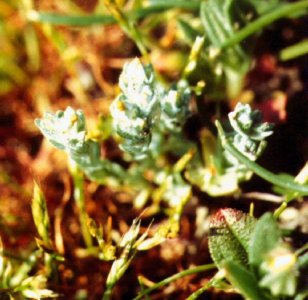 own garden, just across the road) and also in Mannez Quarry. The physical distinctions between the two species are small and I have always assumed, based on earlier records from before 1980, that it was still absent from Alderney and not examined the plants sufficiently closely. C. canadensis, originating in Canada, has yellowish-green, hairless or sparsely hairy phyllaries, green leaves with well spaced, straight, hairs on the margins. (Phyllaries are the sepal like involucral bracts, in rows round the outside of the capitulum or head of Daisy family flowers). It was first recorded in
own garden, just across the road) and also in Mannez Quarry. The physical distinctions between the two species are small and I have always assumed, based on earlier records from before 1980, that it was still absent from Alderney and not examined the plants sufficiently closely. C. canadensis, originating in Canada, has yellowish-green, hairless or sparsely hairy phyllaries, green leaves with well spaced, straight, hairs on the margins. (Phyllaries are the sepal like involucral bracts, in rows round the outside of the capitulum or head of Daisy family flowers). It was first recorded in
 Guernsey in 1876 and then not again until 1947. There it is locally frequent and mainly found in the sandy north part. It is common in Jersey and locally frequent in Alderney. C. sumatrensis, despite its name, comes from Peru and was first recorded in Guernsey in 1961, its first record anywhere in the British Isles. By the mid 1970s it was described as frequent in the north of Guernsey, locally abundant in Jersey, but absent from the other islands. The phyllaries are greyish-green, hairy or densely so and the greyish-green leaves have many hooked hairs along their margins.
Guernsey in 1876 and then not again until 1947. There it is locally frequent and mainly found in the sandy north part. It is common in Jersey and locally frequent in Alderney. C. sumatrensis, despite its name, comes from Peru and was first recorded in Guernsey in 1961, its first record anywhere in the British Isles. By the mid 1970s it was described as frequent in the north of Guernsey, locally abundant in Jersey, but absent from the other islands. The phyllaries are greyish-green, hairy or densely so and the greyish-green leaves have many hooked hairs along their margins.
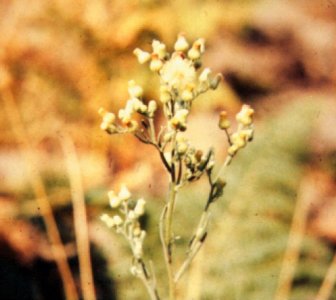 Conyza sumatrensis (L), C. canadensis (R)
Conyza sumatrensis (L), C. canadensis (R)
Long grass and bracken are drying off everywhere and t
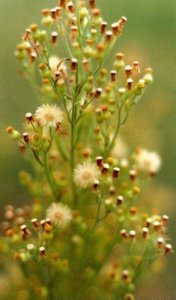 he leaves are already falling from many Sycamores, some already completely bare of leaves. On Longis common, near the top of the steep slope to the NE of Longis pond, I noticed for the first time a large patch of Everlasting Flower (Helichrysum petiolare) (photo below left), the grey shrubby mound being covered with the dirty-white flower heads. It must have been there for years !! A few Clouded Yellow butterflies were flying around the c
he leaves are already falling from many Sycamores, some already completely bare of leaves. On Longis common, near the top of the steep slope to the NE of Longis pond, I noticed for the first time a large patch of Everlasting Flower (Helichrysum petiolare) (photo below left), the grey shrubby mound being covered with the dirty-white flower heads. It must have been there for years !! A few Clouded Yellow butterflies were flying around the c
 ommon.
ommon.
9th September. More Clouded Yellows near Fort Corblets, several people have reported seeing them in other places on the island, must be a good year for them. Eight or ten Painted Lady butterflies were around a mauve Buddleja above Mannez pond. Two unidentified Dragonflies were flying around my swimming pool; midway in size between the Emperor and the various Damselflies, they appeared to be the Banded Demoiselle species. A later confirmed report of a caught specimen of this species suggests this was probably a correct identification and adds a new species to our Dragonfly list.
All round the island Italian Arum spikes were now covered in red berries. On the roadside bank on the E. side of La Vallée, more than a dozen plants of the "Compass plant" Prickly Lettuce (Lactuca serriola) were spaced out over about 100m.
At Val du Saue on the south coast the deciduous Elaeagnus (Elaeagnus commutata) was in good fruit and the bushes here had spread further. Along the road to Fort tourgis at Courtil Cartier, the Cyclamen (Cyclamen hederifolium) in the hedge bottom on the E. verge now had about 50-60 blooms on it, three of them white.
11-12th September. Quite a lot of Wheatears were seen in several places, probably passage migrants. At Longis Bay on the afternoon of the 12th, two Cattle Egrets and several Little Egrets were searching for food in shallow pools around the water's edge towards low tide.
14th September. Masses of Old Man's-beard (Clematis vitalba) (photo on left), in seed a
 round the German bunkers along the top of Les Rochers towards the TV relay and around also the edge of the Church Glebe land. A good number of Clouded Yellow, Red Admiral and several other butterflies were seen along the track here at the same time. In the small triangular field by the Willow thicket along Le Grand Val, many small plants of Phacelia (Phacelia tanacetifolia), were flowering near the two beehives in the corner. This was planted here several years ago, but subsequently ploughed in and small numbers of seedlings have appeared round the margins ever since. Tamarisk trees are in flower again in many places round the island, their pinky "catkins" of tiny flowers adding a welcome contrast to the dull grey-green leaves at this time of year. The Duke of Argyll's Tea-plants are also flowering again in many places, their small mauve bells showing brightly amongst the foliage.
round the German bunkers along the top of Les Rochers towards the TV relay and around also the edge of the Church Glebe land. A good number of Clouded Yellow, Red Admiral and several other butterflies were seen along the track here at the same time. In the small triangular field by the Willow thicket along Le Grand Val, many small plants of Phacelia (Phacelia tanacetifolia), were flowering near the two beehives in the corner. This was planted here several years ago, but subsequently ploughed in and small numbers of seedlings have appeared round the margins ever since. Tamarisk trees are in flower again in many places round the island, their pinky "catkins" of tiny flowers adding a welcome contrast to the dull grey-green leaves at this time of year. The Duke of Argyll's Tea-plants are also flowering again in many places, their small mauve bells showing brightly amongst the foliage.
A single patch of Phacelia has suddenly appeared in flower soil above the lower corner of the roadside wall of the new cemetery in Longis Road.
19th September. 50 or 60 Dunlin along the strand line in Saye Bay and a flock of about 100 Meadow Pipits at the bottom of the Albert Glacis, by the Campsite field. The Cyclamen clump in the verge between the Hammond Memorial and the railway crossing has about 50 flowers. Three straggly plants of Common Pigweed (Amaranthus retroflexus), in the verge in La Marette. I've not seen it here before. Red-hot Pokers (Kniphofia spp.) are also flowering again in their several 'wild' spots.
In gardens the Jersey Lilies (Amaryllis belladonna) are comin
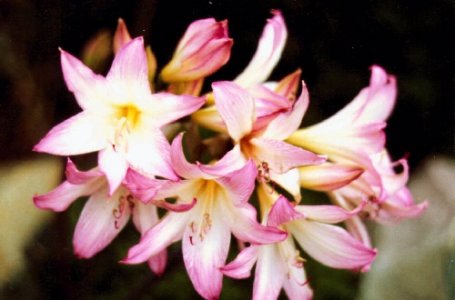 g into flower (photo on right), the next couple of weeks should show a great splash of deep pink and white colour in many island gardens. They are known as 'Naked Ladies' because the flowers appear before any leaves. One patch has also existed 'in the wild' in a grass verge for many years. The stems, about 75-100cm high, can appear and grow to their full height in a couple of days before the flowers open. In my own garden, the even large Crinum lilies (these are Crinum moorei), in theory a greenhouse or conservatory plant, which seems to like our almost frost-free climate, which I grew originally from seed from our indoor ones, have now been outside for 10 years or more and have multiple bulbs some of them as big as 15-20cm across, are also covered in bloom. One patch has 14 stems, each with between 10 and 14 creamy-white, just flushed with pink, flowers in the head, lasting 2-3 days each with three or f
g into flower (photo on right), the next couple of weeks should show a great splash of deep pink and white colour in many island gardens. They are known as 'Naked Ladies' because the flowers appear before any leaves. One patch has also existed 'in the wild' in a grass verge for many years. The stems, about 75-100cm high, can appear and grow to their full height in a couple of days before the flowers open. In my own garden, the even large Crinum lilies (these are Crinum moorei), in theory a greenhouse or conservatory plant, which seems to like our almost frost-free climate, which I grew originally from seed from our indoor ones, have now been outside for 10 years or more and have multiple bulbs some of them as big as 15-20cm across, are also covered in bloom. One patch has 14 stems, each with between 10 and 14 creamy-white, just flushed with pink, flowers in the head, lasting 2-3 days each with three or f
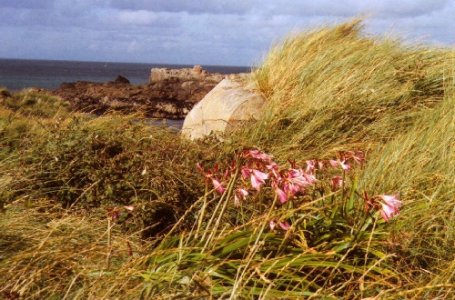 our open at a time on each 1.5-1.75m high stem. The single seeds produced by a few of the flowers are similar in size and appearance to a horse chestnut. When ripe, if left on damp soil they produce a radicle (root), which curves down into the soil and produces a small bulb at the point where in enters the ground. This gradually increases in size over the next few months as the seed is gradually absorbed and shrivels. They then take about 3-4 years to grow before they flower. A slightly smaller and shorter, all pink species, Crinum powellii has survived in the dunes at Saye Bay for at least 45 years (photo on left). This too is in flower at the moment.
our open at a time on each 1.5-1.75m high stem. The single seeds produced by a few of the flowers are similar in size and appearance to a horse chestnut. When ripe, if left on damp soil they produce a radicle (root), which curves down into the soil and produces a small bulb at the point where in enters the ground. This gradually increases in size over the next few months as the seed is gradually absorbed and shrivels. They then take about 3-4 years to grow before they flower. A slightly smaller and shorter, all pink species, Crinum powellii has survived in the dunes at Saye Bay for at least 45 years (photo on left). This too is in flower at the moment.
26th September. A spectacular sight in the afternoon sunshine in The Swinge, just beyond the reef in Clonque Bay and almost opposite the white navigation cone by Fort Tourgis, was literally hundreds of gannets diving into the water, emerging and then flying, in groups of 20+, the half mile or more back to their nests on the Garden Rocks with full crops, to feed their young. There must have been a considerable shoal of fish in the 3-400m square area in which they were diving. This went on for about 15 minutes when they began to disperse, probably having exhausted the supply of fish there.
30th September. The last few days rain and some warmth from the bright sunshine has brought up a good crop of Parasol Mushrooms (Lepiota procera) in a number of places, 23 in one patch about 5m across. The dry late Summer/early Autumn has not given a great crop of any kind of mushrooms this year and we have seen no Giant Puffballs (Langermannia gigantea) in their usual spots. The Parasols were mostly a good handspan across and the four I picked were delicious fried.
On Essex Hill many small plants of Wood Sage (Teucrium scorodonia) were flowering, apparently seedlings from the flowering earlier in the year. Honesuckle was still in good flower in several patches down the sides of the hill and the adjacent cliffs, flowers and berries together on the same plant. The large quantities of Ivy (Hedera helix subsp. hibernica), both here and all over the island were covered in their globular flower heads, many with the bright yellow stamens now showing. The Hawthorns have already lost most of their leaves and at least some of the berries, whilst the Elders have been stripped of fruit. The mauve Buddlejas here were still flowering and a few butterflies were sampling the nectar, Horse and Sweet Chestnuts were covered with, as yet unripe, fruit cases. A few plants of Hedge Bindweed (Calystegia sepium) crawling over the scrub, were still showing their large white trumpet shaped flowers. With the rain and sun of the last few days, the Blackberries were finally swelling, ripening and looking worth picking, but we didn't stop. Some of the plants were still flowering, mostly with small, dark pink flowers. Several patches of bright yellow Tormentil (Potentilla erecta) and odd plants of both Pink and White Campion (Silene x hampeana & S. latifolia), were flowering again in the grassy banks alongside the road up the hill.
The equinoctial gales of the last week have almost stripped the Sycamores of their leaves in exposed spots and gutters are choked with them. The Hawthorns are already bare as noted above and the few remaining Elms have lost some of their leaves. Both Sycamore and Elm fallen leaves in the Longis Road were carrying thickened, almost circular, black spots about the size of a 5p piece or a new penny, which I believe are called Tarspots, but whether they are of fungal or viral origin I have not yet discovered. Any information from readers of this page would be welcomed.
 andy ground or between paving slabs, as at Platte Saline and some of them elsewhere. Jersey Cudweed is rare in Alderney and has only been noted in the Platte Saline area. In Alderney Common and Small Cudweeds are not common anywhere, but Cape Cudweed and Canadian Fleabane are frequent in these sort of habitats, whilst Guernsey Fleabane, not recorded in Alderney before has now become more common in Jersey than the Canadian plant. This month Margaret Long one of the two Jersey BSBI recorders found a number of plants of it on Platte Saline common, (as well as two in my
andy ground or between paving slabs, as at Platte Saline and some of them elsewhere. Jersey Cudweed is rare in Alderney and has only been noted in the Platte Saline area. In Alderney Common and Small Cudweeds are not common anywhere, but Cape Cudweed and Canadian Fleabane are frequent in these sort of habitats, whilst Guernsey Fleabane, not recorded in Alderney before has now become more common in Jersey than the Canadian plant. This month Margaret Long one of the two Jersey BSBI recorders found a number of plants of it on Platte Saline common, (as well as two in my
 own garden, just across the road) and also in Mannez Quarry. The physical distinctions between the two species are small and I have always assumed, based on earlier records from before 1980, that it was still absent from Alderney and not examined the plants sufficiently closely. C. canadensis, originating in Canada, has yellowish-green, hairless or sparsely hairy phyllaries, green leaves with well spaced, straight, hairs on the margins. (Phyllaries are the sepal like involucral bracts, in rows round the outside of the capitulum or head of Daisy family flowers). It was first recorded in
own garden, just across the road) and also in Mannez Quarry. The physical distinctions between the two species are small and I have always assumed, based on earlier records from before 1980, that it was still absent from Alderney and not examined the plants sufficiently closely. C. canadensis, originating in Canada, has yellowish-green, hairless or sparsely hairy phyllaries, green leaves with well spaced, straight, hairs on the margins. (Phyllaries are the sepal like involucral bracts, in rows round the outside of the capitulum or head of Daisy family flowers). It was first recorded in
 Guernsey in 1876 and then not again until 1947. There it is locally frequent and mainly found in the sandy north part. It is common in Jersey and locally frequent in Alderney. C. sumatrensis, despite its name, comes from Peru and was first recorded in Guernsey in 1961, its first record anywhere in the British Isles. By the mid 1970s it was described as frequent in the north of Guernsey, locally abundant in Jersey, but absent from the other islands. The phyllaries are greyish-green, hairy or densely so and the greyish-green leaves have many hooked hairs along their margins.
Guernsey in 1876 and then not again until 1947. There it is locally frequent and mainly found in the sandy north part. It is common in Jersey and locally frequent in Alderney. C. sumatrensis, despite its name, comes from Peru and was first recorded in Guernsey in 1961, its first record anywhere in the British Isles. By the mid 1970s it was described as frequent in the north of Guernsey, locally abundant in Jersey, but absent from the other islands. The phyllaries are greyish-green, hairy or densely so and the greyish-green leaves have many hooked hairs along their margins.
 Conyza sumatrensis (L), C. canadensis (R)
Conyza sumatrensis (L), C. canadensis (R)
 he leaves are already falling from many Sycamores, some already completely bare of leaves. On Longis common, near the top of the steep slope to the NE of Longis pond, I noticed for the first time a large patch of Everlasting Flower (Helichrysum petiolare) (photo below left), the grey shrubby mound being covered with the dirty-white flower heads. It must have been there for years !! A few Clouded Yellow butterflies were flying around the c
he leaves are already falling from many Sycamores, some already completely bare of leaves. On Longis common, near the top of the steep slope to the NE of Longis pond, I noticed for the first time a large patch of Everlasting Flower (Helichrysum petiolare) (photo below left), the grey shrubby mound being covered with the dirty-white flower heads. It must have been there for years !! A few Clouded Yellow butterflies were flying around the c
 ommon.
ommon.
 round the German bunkers along the top of Les Rochers towards the TV relay and around also the edge of the Church Glebe land. A good number of Clouded Yellow, Red Admiral and several other butterflies were seen along the track here at the same time. In the small triangular field by the Willow thicket along Le Grand Val, many small plants of Phacelia (Phacelia tanacetifolia), were flowering near the two beehives in the corner. This was planted here several years ago, but subsequently ploughed in and small numbers of seedlings have appeared round the margins ever since. Tamarisk trees are in flower again in many places round the island, their pinky "catkins" of tiny flowers adding a welcome contrast to the dull grey-green leaves at this time of year. The Duke of Argyll's Tea-plants are also flowering again in many places, their small mauve bells showing brightly amongst the foliage.
round the German bunkers along the top of Les Rochers towards the TV relay and around also the edge of the Church Glebe land. A good number of Clouded Yellow, Red Admiral and several other butterflies were seen along the track here at the same time. In the small triangular field by the Willow thicket along Le Grand Val, many small plants of Phacelia (Phacelia tanacetifolia), were flowering near the two beehives in the corner. This was planted here several years ago, but subsequently ploughed in and small numbers of seedlings have appeared round the margins ever since. Tamarisk trees are in flower again in many places round the island, their pinky "catkins" of tiny flowers adding a welcome contrast to the dull grey-green leaves at this time of year. The Duke of Argyll's Tea-plants are also flowering again in many places, their small mauve bells showing brightly amongst the foliage.
 g into flower (photo on right), the next couple of weeks should show a great splash of deep pink and white colour in many island gardens. They are known as 'Naked Ladies' because the flowers appear before any leaves. One patch has also existed 'in the wild' in a grass verge for many years. The stems, about 75-100cm high, can appear and grow to their full height in a couple of days before the flowers open. In my own garden, the even large Crinum lilies (these are Crinum moorei), in theory a greenhouse or conservatory plant, which seems to like our almost frost-free climate, which I grew originally from seed from our indoor ones, have now been outside for 10 years or more and have multiple bulbs some of them as big as 15-20cm across, are also covered in bloom. One patch has 14 stems, each with between 10 and 14 creamy-white, just flushed with pink, flowers in the head, lasting 2-3 days each with three or f
g into flower (photo on right), the next couple of weeks should show a great splash of deep pink and white colour in many island gardens. They are known as 'Naked Ladies' because the flowers appear before any leaves. One patch has also existed 'in the wild' in a grass verge for many years. The stems, about 75-100cm high, can appear and grow to their full height in a couple of days before the flowers open. In my own garden, the even large Crinum lilies (these are Crinum moorei), in theory a greenhouse or conservatory plant, which seems to like our almost frost-free climate, which I grew originally from seed from our indoor ones, have now been outside for 10 years or more and have multiple bulbs some of them as big as 15-20cm across, are also covered in bloom. One patch has 14 stems, each with between 10 and 14 creamy-white, just flushed with pink, flowers in the head, lasting 2-3 days each with three or f
 our open at a time on each 1.5-1.75m high stem. The single seeds produced by a few of the flowers are similar in size and appearance to a horse chestnut. When ripe, if left on damp soil they produce a radicle (root), which curves down into the soil and produces a small bulb at the point where in enters the ground. This gradually increases in size over the next few months as the seed is gradually absorbed and shrivels. They then take about 3-4 years to grow before they flower. A slightly smaller and shorter, all pink species, Crinum powellii has survived in the dunes at Saye Bay for at least 45 years (photo on left). This too is in flower at the moment.
our open at a time on each 1.5-1.75m high stem. The single seeds produced by a few of the flowers are similar in size and appearance to a horse chestnut. When ripe, if left on damp soil they produce a radicle (root), which curves down into the soil and produces a small bulb at the point where in enters the ground. This gradually increases in size over the next few months as the seed is gradually absorbed and shrivels. They then take about 3-4 years to grow before they flower. A slightly smaller and shorter, all pink species, Crinum powellii has survived in the dunes at Saye Bay for at least 45 years (photo on left). This too is in flower at the moment.